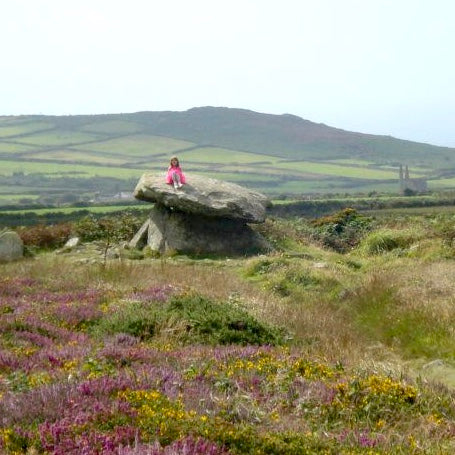Ancient, Mystical Cornwall

Dancing maidens turned to stone, majestic menhirs and mystical fougous.
This week is the festival of British Archaeology and we are joining the celebration by exploring the wonderful Cornish landscape; a bountiful labyrinth of Neolithic and Iron Age sites. From stone circles of dancing maidens frozen in time to majestic megaliths and hidden fougous.
Let us take you on a journey through mystical Cornwall where secrets are revealed and stories of ancient man, myth and magic unfold. But, what is a fougou?, I hear you say.
Fougous and early settlements
A fougou (pronounced “foogoo”) is an underground, dry stone structure found typically in Iron Age or Romano-British defended settlement sites in Cornwall. One of the most famous and best-preserved Iron Age villages is Carn Euny, located near Sancreed on the Penwith peninsula. Exposed in the 1860’s by the antiquarian William Copeland Borlase, who researched and documented many sites across Cornwall, the spectacular 65 foot fougou was restored during excavations between 1964-72. The settlement site includes nine hut foundations that were a hive of constant activity from the Neolithic period right up to the late Roman period. Visitors today can explore this marvellous step back in time and wander underground into the fougou itself – what will you discover?
Fougou means ‘cave’ in Cornish and they are open at both ends with a large stone slab roof and sometimes with additional entrance tunnels. We are still not sure what they were used for however, archaeologists debate that it could be for the safe, cool storage of food and supplies to quick entrance and exit tunnels into the heart of the settlement as a form of safety and protection or even a place for ceremony and ritual deep in the womb of the earth - connecting the village folk to ancestors and mother nature.


(Carn Euny settlement and fougou chamber)
Stone Circles
Cornwall has a wealth of stone circles whether nestled in the heart of the moorlands to the awe-inspiring cliff tops overlooking the sea. Dating back to the Neolithic or Early Bronze Age they vary in size but there are many common characteristics. Circles are deemed to have been a key place for ritual ceremony and community gathering. The stones in Cornwall are often shot with granite and it is understood that circles and any outlying standing stones (on ley lines) are astronomically positioned. The alignment with the sun and moon at key solstice or equinox points of the year is to track the movements across the landscape – the granite catching the light and marking a connection with earth and sky.
One of our favourite and prettiest is the Merry Maidens stone circle close to Penzance where folklore states that the Cornish maids were dancing on the sabbath and turned to stone. Musicians suffering the same plight became the large megaliths nearby called the ‘Pipers’. The Cornish ‘Zans Meyn’ means sacred stone.
Walking up the gentle slope to the beautiful circle, the whispering wind creates a timeless feel and birdsong echoes from the hedgerows. The circle dates back to 2500-1500BC and is well preserved and can be visited easily, sitting proudly on the prehistoric landscape near Lamorna. The regular spacing between the stones makes it truly circular in form and unusual in Cornwall with 19 stones altogether and a gap at the eastern section – common to all British stone circles. The stones also diminish in size from the southwest to the northeast and this waxing and waning in size is believed to mirror the cycle of the moon.
The Merry Maidens is protected by ASLAN – Ancient Sacred Landscape society and Cornish heritage and still used by many for magical ceremonies and Celtic and pagan festivities such as dancing around the maypole on May Day – the Celtic fire festival of Beltane – where laughter fills the air.


Menhirs
Megaliths are scattered across Cornwall’s rich landscape. Travelling through you may have spotted a rather unusual shaped stone, tall or holed and in a wall, hedgerow, field or garden. These menhirs are part of Cornwall’s heritage and are typically aligned to prehistoric burial sites, other standing stones or sacred places and mark a key point on a path or an astronomical connection.
‘Men’ means stone in Cornish and ‘Menhir’ is a tall, upright stone. ‘Men an Tol’ means stone with a hole.
The former rock god and poet, Julian Cope, has explored and researched many ancient sites across Britain and meticulously recorded them in his book ‘The Modern Antiquarian’, introducing new ideas and archaeological theory also in ‘Romancing the Stones’.
One such record, details the stones in our very own parish of St. Eval. The first large Menhir stands at 3m high x 1.5m across and sits in the hedge near a minor road just south of Newquay Airport. It is a pinky/white colour, the same as the menhir at St. Eval church which is just across the airfield.


There is a Bronze and Iron Age settlement at Trevisher, one mile to the east and it is believed there were 6 barrows around St. Eval church which were destroyed during the construction of the airfield.
Inside the church there are 7 Green Man ceiling bosses placed high in the rafters representing the connection between Pagan and Christian religions still valued and celebrated in Cornwall life today.
We hope that you have enjoyed this little insight into the beauty of Cornwalls rich and diverse archaeology, mystical and sacred today as it was 4000 years ago.
If you are visiting the land of Kernow (Cornwall) be sure to tread softly on the earth and do explore the wonder of these sacred sites.
References:
Cornwall Life - behind the legends and folklore of Cornwall, Aug 2017
https://www.cornwalls.co.uk/history/sites/carn_euny.htm
The Modern Antiquarian, Julian Cope.
https://archaeology-travel.com/archaeological-sites/merry-maidens-dancing-on-a-sunday-in-cornwall/
https://www.megalithic.co.uk/article.php?sid=118
If you would like any further information please contact us at: marketing@st-eval.com.
#stevalcandles


